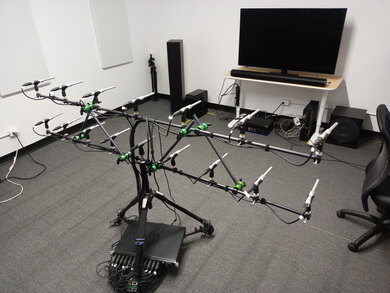For many listeners, it's important to have a soundbar with a clean and pure audio reproduction. Total harmonic distortion, or THD, represents the number of unwanted frequencies that the soundbar reproduces alongside the intended frequencies. It's a comparison between the input signal (the TV show, music, or movie) and the output signal (the audio as it's played by the soundbar). Ideally, your soundbar doesn't have too much distortion, so your audio content sounds the way it's intended to be heard by whoever mixed it.
To evaluate the total harmonic distortion performance, we measure the weighted THD at normal listening volume and its maximum volume.
Test results
When It Matters
Total harmonic distortion is important for listeners who care about the fidelity of sound reproduction. A soundbar with less THD can reproduce audio content closer to how it was designed to be heard, without too many unintended frequencies that could take away from your listening experience. If you like to listen to your audio at louder volumes, this is especially important since many soundbars see a jump in THD when pushed to their maximum volume.
That said, total harmonic distortion can be difficult to hear with real-life content. As a result, this measurement may not be as important for more casual listeners.
Our Tests

For our stereo total harmonic distortion tests, we measure the soundbar's weighted THD at a normal listening volume and its maximum volume. We calibrate the soundbar to 80 dB SPL using an SPL meter, which is considered a normal listening volume for most users. Then, we apply a spectrally pure sine wave and use the microphone array to measure the output. By comparing the input to the output, we can determine the amount of distortion. We also run this test with the soundbar set to its maximum volume.
We perform our stereo total harmonic distortion tests alongside our stereo frequency response and stereo dynamics tests. We use a room that's 20' (L) x 16' (W) x 9.5' (H), with one couch and minimal sound treatment to better represent a typical living room. The soundbar and the table it sits on are placed 7.5 feet away from our microphone array. We use a laser measuring tool to ensure that the microphone array, table, and soundbar are at the appropriate distance from the side walls, as well as the subwoofer and the satellites if they're included in the setup. We measure the THD with the soundbar in a stereo setup, so if it's possible, the surround channels aren't active during these tests.
ST Weighted THD @ 80db SPL
Most of the time, you'll probably listen to audio content on your soundbar at more moderate volumes. For this test, we measure the amount of total harmonic distortion with the bar set to a normal listening volume of 80 dB SPL. Our measurements give more weight to higher frequencies since you're more likely to perceive distortion at those frequencies.
We consider a good value to be below 0.7. However, higher amounts of THD may not be very noticeable with real-life content, especially if you're a more casual listener.


ST Weighted THD @ Max Volume
If you like to listen to your audio at crowded parties or in large spaces, you may want to crank up the volume on your soundbar. In those cases, you'll want to ensure that the soundbar's audio reproduction doesn't noticeably deteriorate at louder volumes. For this test, we measure the total harmonic distortion when the soundbar is pushed to its maximum volume. Our scoring system gives more weight to higher frequencies since you're more likely to perceive those when listening to your audio.
For this test, we consider a good value to be below one. That said, most soundbars that we've tested have a jump in THD at their max volume. By comparing the results at a normal listening volume with the results at max volume, you may notice that there's a jump in THD at certain frequencies, like in the bass or the treble ranges. Again, it may not be too noticeable with real-life content, so it's most important for listeners who care about the fidelity of their audio reproduction.
Conclusion
If you want a soundbar with a clean and pure audio reproduction, you'll want to check out its total harmonic distortion performance. Total harmonic distortion measures the number of unintended frequencies the soundbar reproduces, which can take away from the fidelity of sound reproduction. The less distortion, the better, since that means that your soundbar reproduces content the way it's intended to be heard. We test for total harmonic distortion at a normal listening volume and max volume since many soundbars see a jump in THD at higher volumes.